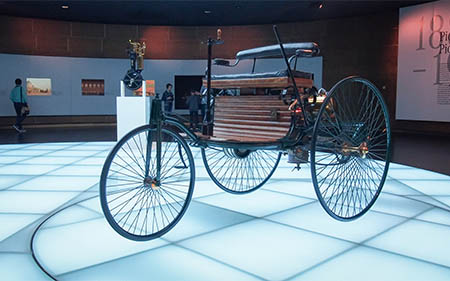In the realm of vehicular innovation, few components are as iconic and integral as the steering wheel. This circular interface between driver and machine has undergone a remarkable journey from its rudimentary origins to the sophisticated control hub it is today.
Let’s delve into the fascinating evolution of the steering wheel, from its humble beginnings to its cutting-edge iterations and the tantalising possibilities of its future.
What Was Before the Steering Wheel?

Before the introduction of the steering wheel, vehicles employed a variety of mechanisms for steering control. One such method was the tiller, a lever-like apparatus that required physical exertion to navigate.
When Karl Benz patented the first car in 1886, the prevailing mode of transport was the horse-drawn carriage. Coachmen were accustomed to steering using reins, and directing the horses by pulling them left or right. This tradition carried over into early automobiles, where the front wheels were controlled by a basic tiller. However, tillers lacked the ergonomic efficiency and user-friendly design of modern steering wheels.
The First Ever Steering Wheel
The credit for inventing the modern steering wheel is often attributed to Alfred Vacheron, a French engineer who adapted his motor car design in the late 19th century. The Frenchman made a significant change to his Panhard & Levassor by replacing the tiller with a steering wheel.
This alteration aimed to enhance steering sensitivity and control for the Paris to Rouen race in July of that year. The innovation was intended to boost the vehicle’s speed during the race. Then, in 1900, Daimler-Motoren-Gesellschaft introduced an angled steering wheel in place of the vertically positioned one in the Phoenix racing car, marking the birth of the modern steering wheel as we know it today.

Therefore, this innovative concept allowed for more precise and effortless manoeuvring, revolutionising the driving experience.
Modern-Day Steering Wheels and Their Features
Fast forward to the present day, and steering wheels have evolved into sophisticated control centres, boasting a plethora of features designed to enhance comfort, convenience, and safety. These controls may include audio adjustments, cruise control activation, gear shifting capabilities, and cluster control for navigating digital displays and accessing essential vehicle information.
Today’s steering wheels are packed with features, including:
- Cruise control: Maintain a constant speed without pressing the accelerator pedal.
- Audio control/channel control: Easily manage your music or radio stations.
- Heated: Provides warmth for chilly mornings.
- Adjustable: Tilts and telescopes for optimal comfort and reach.
- Gear adjustment: Switch between gears (automatic or manual) without taking your hands off the wheel.
- Cluster control: Operate your car’s digital display and information hub.
Ergonomics Take the Wheel:
Modern steering wheels prioritise comfort and safety with features like:
- Flat-bottomed designs: Offer more legroom for taller drivers.
- Thickened grips: Enhance control and reduce fatigue.
- Thumb controls: Place essential functions within easy reach.
Steering Wheel Covers: Protection and Personalisation
Steering wheel covers offer added grip, protection against wear and tear, and a touch of personalisation. Options include:
- Heated covers: Provide extra warmth.
- Sports steering wheel covers: Enhance the sporty feel of your car’s interior.
Contemporary steering wheels often incorporate multifunctional controls, allowing drivers to effortlessly manage various vehicle functions without diverting their attention from the road.
Spokes of Style: Exploring the Varieties
The number and design of steering wheel spokes have mirrored the broader changes in automotive technology and aesthetics. Early automobiles primarily sported four-spoke wheels, offering structural stability and easy gripping. The iconic “Banjo” wheel, with its wire spokes, emerged in the early 20th century, providing a buffer against road vibrations. Three-spoke designs gained popularity later, offering a sleeker look and potentially better visibility of the instrument cluster. As safety became a priority, collapsible spokes and airbag integration led to thicker, sturdier designs.
Modern wheels offer a diverse range, from sporty three-spoke configurations to multi-spoke variations that accommodate a growing array of integrated buttons and controls. Even futuristic yoke steering wheel designs, like those seen in Tesla’s, break away from tradition, showcasing the continuous evolution of this crucial vehicle interface. The journey of steering spokes reminds us that even seemingly minor design elements can reflect major shifts in technology, safety, and driving experience.
How Steering Wheels Changed Vehicle Sports
The evolution of steering wheels has significantly influenced vehicle sports, particularly in the realm of motorsports. F1 steering wheels (Formula One), for instance, are marvels of engineering, equipped with an array of buttons, knobs, and switches that enable drivers to fine-tune their cars’ performance on the fly. These high-tech steering wheels facilitate split-second decisions and adjustments, contributing to the competitive edge in races.
Gaming Steering Wheels
Beyond the realm of real-world driving, steering wheels have also made a substantial impact in the gaming industry. Gaming steering wheels simulate the tactile feedback and immersive experience of driving, elevating the realism of racing simulations and enhancing gameplay for enthusiasts.
The Future of Steering Wheels
As technology continues to advance, the future of steering wheels holds exciting possibilities. From the integration of artificial intelligence to enhance autonomous driving capabilities to the development of innovative materials for lightweight yet durable designs, the evolution of steering wheels shows no signs of slowing down.
In conclusion, the steering wheel stands as a testament to human ingenuity and innovation, transforming the way we interact with vehicles and shaping the landscape of transportation. As we look towards the future, one thing remains certain: the journey of the steering wheel is far from over, with boundless potential waiting to be unlocked.





